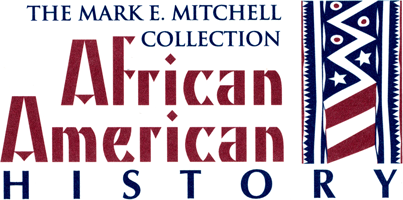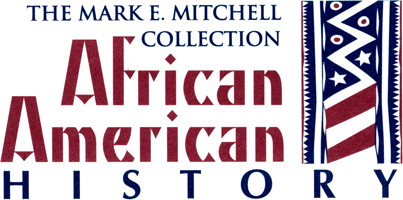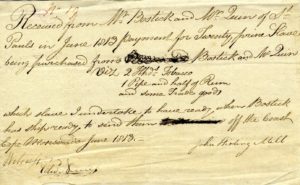Exceedingly Important African Slave Manuscript. Bill of Sale for Slaves from the Bostock and McQueen Bunce Island Slave Factory off the Coast of Sierra Leone, West Africa, signed by John Stirling Mill and witnessed by Edward Neede, in June, 1813.
Robert Bostock’s father (also named Robert), was a Liverpool slave trader and ship’s captain who worked the Windward Coast of Africa in sending slaves throughout the Caribbean. Before his death in 1793, he and his two sons ran a slave factory on the Rio Nunez River in modern-day Guinea. Sometime after 1809, Robert formed a partnership with John McQueen and five local chiefs to resume the illegal operation of St. Paul’s Slave Factory on Sierra Leone’s Bunce Island.
Although a very small island, historians cite the size and strategic importance of Bunce’s castle among some fifty European sites; that it was uniquely accessible to seagoing as well as canoes and low-drafted upriver craft in sourcing captives; that its Africans could command higher prices for their rice-growing skills; and that it was the point of embarkation for some 50,000 Africans to North America and the West Indies during the legally sanctioned slave trade between 1668 to 1807.
But few know the story of what happened afterwards. On January 1, 1808, Parliament made Sierra Leone a Crown Colony and removed it from chartered company control. On that date it also forbade British subjects and American citizens from selling, purchasing, or transporting slaves from Africa. Upon learning of the latter stricture in 1813, Governor Charles Maxwell ordered Royal Navy Captain Edward Scobell to seize the two British slave traders on Bunce Island.
Above, actual proof of their illegal activities. In full:
“Received from Mr. Bostick [sic] and Mr. Quin [sic] of St. Pauls in June 1813 payment for Twenty prime Slaves being purchased from Bostick and McQuin
Viz 2 Hhds Tobacco [in hands, total is approx. 9-inch stack of cured leaves]
1 Pipe and half [barrel] of Rum
And some Trade goods
Which slaves I undertake to have ready when Bostick has ship ready to send them off the Coast Cape Mesurado June 1813.”
This receipt signed by Mill, another local slave-trader, means that when the receipt-holder, presumably the witness, Edward Neede, returns with his ship, Mill will facilitate boarding his slaves without delay, having already tendered the aforesaid goods to Bostock and McQueen. (These kind of precautions are explained in “General Orders for U.S. Navy” in this category section.)
On June 27, 1813, the shadowy operation was raided by Capt. Scobell’s sloop H.M.S. Thais and the colonial armed schooner Princess Charlotte, resulting in the capture of 233 slaves in the midst of embarkation. Also taken were the targeted traders, Bostock and McQueen, as well as Mill, Neede, and Mason, and the three vessels mentioned in Tom Bau’s deposition that were to have conveyed the contraband slaves to Charleston, SC. But this didn’t close the final chapter on Bunce Island’s career.
This item’s notation at top (No. 19), and Bau’s deposition (No. 12), indicate they were listed as evidence for the Court of Vice Admiralty’s case against Bostock and McQueen, who were found guilty and sentenced to 14 years in a penal colony. Mill also pleaded guilty. Notwithstanding, the three miscreants reached Portsmouth, England just after the ship that was to have taken them to Australia had departed. Through a solicitor, they appealed their sentences, and inexplicably their case made it to London’s Privy Council, the highest court of the realm, whereupon Bostock and McQueen were quietly removed to Sydney and granted full pardons by 1816.
Such political hypocrisy stemmed from diplomatic crises over the Navy’s raids and seizures of Spanish and Portuguese slave factories and slavers all along the Windward Coast. Chief Judge Robert Thorpe of Sierra Leone’s court responded to this outrage by returning to England. Once there, he persuaded the European slave-powers to negotiate a new and currently used model of international law, with tribunals constituted by treaty for the adjudication and condemnation of slave-traders and their vessels.
Surviving ephemera such as these verified eyewitness and firsthand proofs of the Atlantic Slave Trade – not to mention their extended stories behind and fascinating consequences beyond – are practically unheard of today.


